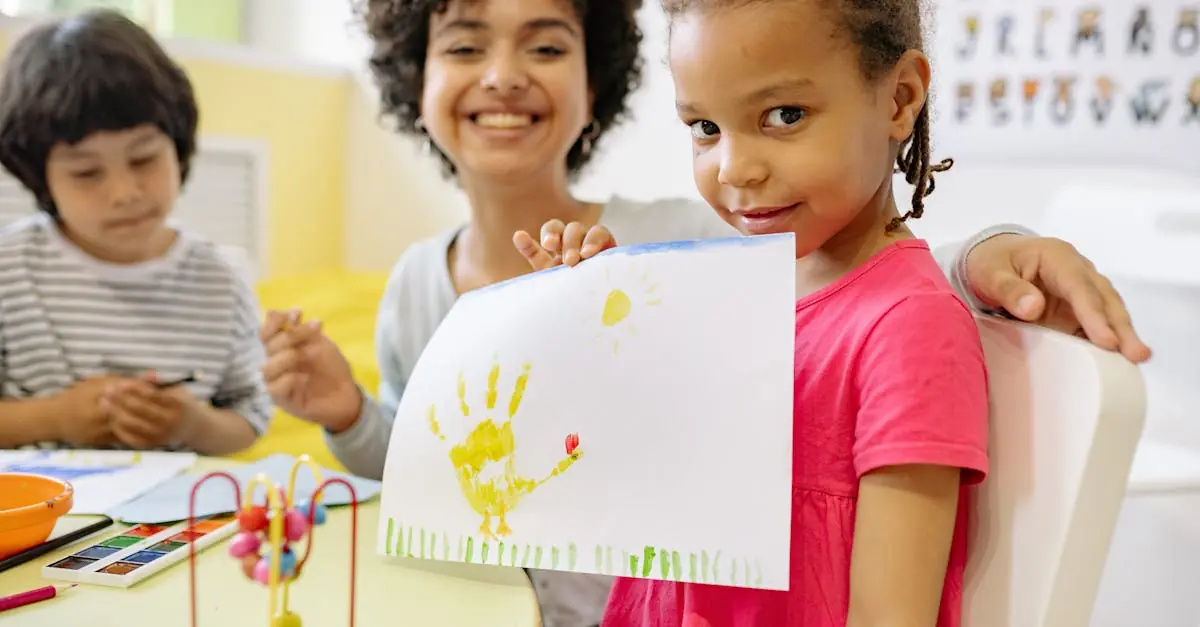Table of Contents
ToggleElementary school art projects are the secret sauce to sparking creativity in young minds. Imagine a classroom buzzing with excitement as kids unleash their inner Picassos, transforming simple supplies into masterpieces. From finger painting to paper mache, these projects not only keep little hands busy but also help develop essential skills like problem-solving and teamwork.
Overview of Elementary School Art Projects
Elementary school art projects encompass a wide range of activities designed to nurture creativity in children. Engaging students in diverse artistic pursuits, such as drawing, painting, and sculpture, offers opportunities for self-expression. Projects like finger painting allow kids to explore texture and color, while paper mache provides a hands-on experience with three-dimensional art.
Art projects foster several essential skills beyond creativity. Problem-solving is enhanced as students figure out how to bring their ideas to life. Teamwork flourishes during collaborative projects where kids share materials and ideas, learning the importance of cooperation. These projects also develop fine motor skills through activities involving cutting, gluing, and assembling various materials.
Teachers often integrate art projects into core subjects to create interdisciplinary learning experiences. For example, a nature-themed art project might incorporate science lessons about ecosystems, allowing students to express their understanding visually. Ultimately, these creative endeavors keep children actively involved and excited about their learning environment.
Interactivity plays a crucial role in the success of art projects. For instance, using large canvases invites teamwork and larger-scale creations, encouraging students to collaborate and share their artistic visions. Encouraging exploration and experimentation can lead to unexpected results that enhance creative thinking.
Elementary school art projects contribute significantly to the holistic development of children. They stimulate imagination, encourage self-confidence, and promote a love of learning. Each artistic endeavor reinforces the idea that creativity is valuable and worth exploring. Through this hands-on approach, students gain a deeper appreciation for art and its role in their lives.
Benefits of Art Projects in Elementary Education
Art projects in elementary education foster numerous advantages for young learners. Engaging in creative activities encourages children to explore their ideas while developing crucial skills.
Enhancing Creativity
Creativity thrives through art projects. Children experiment with colors, shapes, and materials, producing unique artworks that reflect their thoughts. Art projects stimulate brain activity, inspiring imaginative thinking. Various forms of art, such as painting or collage, offer students multiple avenues for expression. These experiences not only boost creativity but also enhance problem-solving abilities. Children learn to approach tasks from different angles, adapting their thoughts to find solutions. Collaboration during group projects further cultivates creative exchange among students. Overall, these experiences foster an environment where innovative ideas flourish.
Developing Fine Motor Skills
Fine motor skills improve significantly through art projects. Activities like cutting, gluing, and painting require precise hand movements. Young learners refine their dexterity as they engage with diverse materials. Manipulating tools, such as paintbrushes and scissors, builds coordination and strength in their hands. Engaging in these tasks prepares them for future academic endeavors, such as writing and typing. Children gain confidence as they master these skills while creating art. Additionally, art projects encourage attention to detail, helping students focus on intricate aspects of their work. This combination of skill-building and creativity contributes to holistic development.
Types of Elementary School Art Projects
Elementary school art projects encompass a variety of creative activities that nurture students’ artistic expression. Each type engages students in unique ways.
Drawing and Painting
Drawing and painting comprise foundational art activities that foster creativity. Students explore various mediums, including pencils, crayons, and watercolors. Teachers introduce techniques that allow children to experiment with colors and textures. Encouragement to depict their thoughts visually inspires confidence. Engaging in these projects enhances fine motor skills and drives imagination.
Sculpture and 3D Art
Sculpture and 3D art present opportunities for tactile experimentation. Students use materials like clay, cardboard, and recycled objects to create three-dimensional works. Projects often focus on building forms and structures, encouraging problem-solving and innovation. Teachers guide students in understanding balance and proportion, enhancing spatial awareness. Through hands-on experiences, children gain a deeper appreciation for art and craftsmanship.
Collage and Mixed Media
Collage and mixed media projects invite children to combine various materials creatively. Students cut and glue papers, fabrics, and other objects to create visually stimulating compositions. The freedom to explore colors, shapes, and textures nurtures personal expression. Instructors emphasize the importance of layering and composition, introducing basic artistic principles. Collaborative collage projects also encourage teamwork and communication among classmates.
Tips for Successful Art Projects
Successful art projects often stem from careful preparation and thought. Both material selection and the learning environment play critical roles in the outcome of the project.
Selecting the Right Materials
Choose materials based on the project requirements and students’ skill levels. Educators should consider using non-toxic paints, sturdy paper, and safe cutting tools. Quality materials can enhance creative expression and support various techniques. Incorporating a mix of supplies, like natural elements or recycled items, encourages exploration and environmental awareness. Ensure each student has access to materials to promote inclusivity and individual expression. By providing a diverse range of resources, teachers can inspire unique creations and foster artistic development.
Creating a Supportive Environment
Fostering a positive atmosphere is essential for creativity to thrive. Arrange the classroom to promote collaboration, such as setting up communal workstations. Offer encouragement and constructive feedback to build students’ confidence. Allowing time for experimentation helps students feel comfortable with their artistic choices. It’s crucial to celebrate every achievement, no matter how small, to motivate continuous engagement. Establishing clear expectations while remaining flexible encourages students to express themselves freely. A supportive environment enhances learning, enabling children to take risks and explore their artistic potential.
Elementary school art projects play a crucial role in nurturing creativity and essential skills among young learners. These hands-on experiences not only engage students but also inspire them to explore their artistic potential. By integrating art with core subjects, teachers enhance interdisciplinary learning and deepen students’ understanding of various concepts.
The diverse types of projects, from drawing to sculpture, provide unique opportunities for personal expression and collaboration. With careful preparation and a supportive environment, children can thrive in their creative pursuits. Celebrating their achievements fosters confidence and a lifelong love of learning. Embracing the value of art in education ultimately enriches the overall development of children, paving the way for imaginative thinkers and problem solvers in the future.





